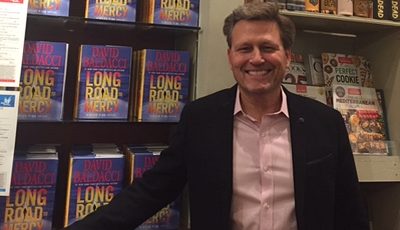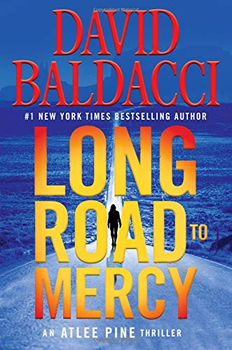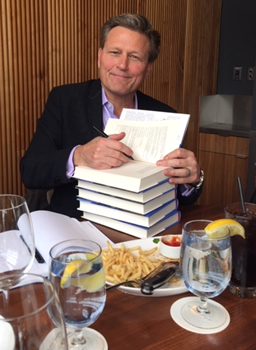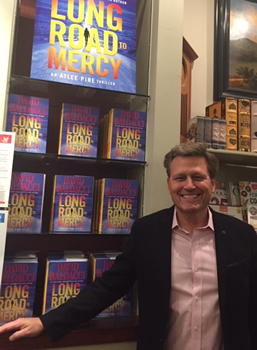

Between The Lines: David Baldacci by Josie Brown
Keeping it Razor Sharp
 By Josie Brown
By Josie Brown
According to bestselling author David Baldacci, when you’ve written as many books as he has—10 series, or a total of 30 books and counting; and another 12 stand-alone novels—there’s one way to keep his writing razor sharp: “Start from Square One: create a new character, a new series—a new world.”
With his latest novel, LONG ROAD TO MERCY, Baldacci has done just that. His new protagonist, female FBI agent Atlee Pine, must cover a desolate Far West outpost on her own. And although its size is intimidating—it includes Grand Canyon National Park—Atlee is strongly motivated to succeed. She sees it as a way to avenge the tragic death of her twin sister, Mercy, who was abducted by a serial killer when the girls were only six years old.
The fact that the killer, Daniel James Tor, played Eeny, Meeny, Miny Mo to decide which of the twins to take with him has always haunted Atlee.
“She finds herself leading two lives: one for herself, and one for her sister, who never had the opportunity to realize her potential, her ambitions, her dreams,” Baldacci says. “She never got justice with her sister. She had no idea what even happened to her. She never had justice, resolution, or closure. By joining the FBI, she can achieve all of those things for other victims. That’s really the only way she can keep going. Still, I’m hoping that one day, she’s going to realize those things for herself.”
Atlee’s grim backstory may be her cross to bear, but her uncanny ability to interpret a few sparse clues about a seemingly unimportant missing person and a gutted mule puts her in the middle of a geopolitical chess game.
When it came to plotting and scheming LONG ROAD TO MERCY, Baldacci seems to have enjoyed every minute of it. “It got me out of my comfort zone. It challenged me to pretend it was my first novel again.”
Atlee is a former Olympic-caliber bodybuilder. She’s also very tall: almost six feet. In other words, she’s no willowy supermodel. (Although should the character be optioned for either the big or small screen, she’d be the perfect role for the former model and Atomic Blonde Charlize Theron.)
And she’s certainly not the image of your typical heroine. Even Atlee’s first name sets her apart. For Baldacci, it holds historical significance. “I had the name ‘Atlee Pine’ in my head pretty early on. It’s an old Southern name. It can be either a man or a woman’s. I grew up in Richmond (Virginia). Outside of the city is a place called Atlee, and there’s a high school—Atlee High School. When you go down the interstate, and you turn off an exit where my parents used to live, if you went to the right, you went to their house; if you went to the left, you went to Atlee.”
There are some very clear differences between Atlee and Baldacci’s other female protagonists: government-sanctioned assassin Jessica Reel (Will Robie series) and ex-Secret Service agent Michelle Maxwell (King and Maxwell). “Atlee’s goal is to join the FBI. Yes, there are women in the FBI, but it’s still predominantly male. So, physically, mentally, and emotionally, she had to prepare herself for this minefield of male domination. She was a weightlifter in college—something that is an advantage in law enforcement. Not only does she have to succeed to do her job, but she also wants to thrive there. Just like any other situation like that: a woman goes in, and she has to work twice as hard and twice as long to reach the same level as a man. It’s just the way it’s set up, unfortunately. But that was her goal.”
Baldacci opens the book with Atlee’s confrontation with Tor, who is being held in ADX Florence, the only supermax prison in the federal system. “One of his taunts that hits home with Atlee is that he has defined her life. He’s thrilled by this because he has a semblance of control over her. I don’t think Atlee would see it in the same way, but I think she does understand that her past loss has defined her somewhat, has left its mark. She’s human, just like anyone else. There’s no way around that. You can’t just completely blank that from your mind. What she has to do is to learn to live with it. But she can move forward productively and do her job at the same time.”
Baldacci has put a unique group of characters around Atlee. One is Carol Blum, Atlee’s prim, middle-aged office assistant.
“I thought, ‘What kind of relationship would be good and productive for Atlee?’ She doesn’t have a great one with her mother. So, in steps Carol Blum. When I first started writing her, she was just going to be ‘the secretary.’ I thought, ‘Is she going to be part of the comedic timing, or is she going to play a significant role?’ As I kept writing Carol onto the page, I saw more and more possibilities for what I could do with her character. A quarter of the way through the book, I realized she’s going to be a star in it. She’s productive and smart; she’s seen a lot in life. She’s raised six kids. That’s a Herculean effort, in and of itself! You have to be clever to get through it, particularly as a single mom.”
In most thrillers there’s a guy in the middle of the action. Or a guy and a gal. Or two guys. It’s almost never two women, and certainly not two women of different generations.
“You just don’t see that,” Baldacci says. “It was a way for me to challenge myself. Could I write this relationship realistically, and do it well so that these characters evolve and grow, and become more important to each other in the course of the book?”
By the time he got to the end of the novel, he loved Carol’s character. “She’s not going to be Atlee’s equal, but she will be a major source of help for her. The way in which she draws on her maternal instincts and her life experiences to gain the witnesses’ trust makes her a valuable tool, ally, and partner for Atlee.”
Having been at the FBI for several decades, Carol is also a wealth of knowledge of agency history, lore, and procedure. But what she isn’t: an FBI agent. However, in this series, it may work in her favor. “Back then, that would have been impossible. I don’t know when the first female special agent was hired. There couldn’t have been all that many. Still, Carol’s greatest strength is her life experience.”
As is her innate wisdom. An example: Atlee’s attacker made a hole in the wall with his fist—and another, with his head, when Atlee was done with him. During the office remodel, Carol makes a canny suggestion: “Keep the dents. A picture is worth a thousand words.”
“I love this woman!” Baldacci says—proof positive that he enjoys shaping, and living with, his characters. “It’s great when there’s that connection. You can’t break it.”
Another wonderful side character is Frank Stark, an FBI agent and mentor to Atlee during her first-year probationary assignment. “Atlee’s father committed suicide on the twins’ birthday,” Baldacci says. “In the FBI, there’s a lot of mentoring going on. Some agents are better at it than others. Atlee is a loner, an introvert. She doesn’t really like being around people, although her job demands that she builds consensus and work with other people—which she does. Still, she doesn’t give herself away easily. She doesn’t get into personal stuff with anyone.”
Stark’s way of breaking through Atlee’s emotional vault: he asks her to help him restore a 1967 Ford Mustang.
“Building the car was a metaphor for building a relationship,” Baldacci says. “It takes a lot of teamwork, and you learn something about somebody along the way. It was a test: does she have what it takes to succeed in the FBI? Does she have what it takes to work on the project long-term, and as a teammate with someone else? She passed all those tests with flying colors. But, really, it gave her a pseudo-father figure; someone she could rely on.”
Because Stark has died before the story begins, readers see him only in backstory and flashbacks. Still, Baldacci insists, “The way Atlee turned out as an agent was due in no small measure to her relationship with Stark.”
And the car plays a significant role in the story’s chase scenes—not to mention Atlee and Carol’s “Thelma and Louise” exploits. Says Baldacci: “For Atlee, the Mustang represents so many things. We’ll continue to see it in future books.”
The author’s vivid descriptions of Grand Canyon National Park bring the story’s central location to life. “When I visited last year, I found it mesmerizing, surreal, enormous, impressive—but also foreboding and forbidding. I wanted the canyon to be a character in the novel; to show the physicality of the challenge of surviving in a climate like that when moving up and down and through it. It’s an unforgiving environment.”
If you want to go down into it and come back up, you have to be respectful of the environment, Baldacci says. “Otherwise, it’ll kill you. Every year, people die in the Grand Canyon because they think they can do far more than they can. They think, ‘It’s just a day in the park; what’s the big deal?’ To their chagrin, they find out it is quite a big deal. We live in the 21st century, where there’s an Uber on every corner. You just have to dial it up on your phone. Every convenience is a phone call away. But there are still a lot of places on Earth where none of that matters. When you’re in the middle of the Grand Canyon, the last thing you want to have in your hand is a smartphone because it’s utterly worthless to you. You would exchange a thousand Apple iPhones for a bottle of water.”
In fact, the book’s climactic rescue takes place inside the canyon. While plotting it, Baldacci’s research in the canyon’s trails was extensive. “There are a couple of major trails used by climbers, on both the north and south faces of the canyon. But they are arduous, and none would have worked. There are other trails—primitive and otherwise—that are not maintained. It’s not like climbing El Capitan, but it’s not that far removed from it, either. It was going to be a difficult trail to the North Rim.”
In LONG ROAD TO MERCY, many of the players who could create world-ending geopolitical conflicts—Russia, North Korea, and yes, the United States—are taken out of their usual arenas—Washington, DC, and other world capitals—and placed where you’d least expect them: a lone outpost deep in America’s heartland.
“Leadership—especially as it pertains to the direction the country is going—matters a lot,” Baldacci says. “The plot is complicated in one way but incredibly simple in another: it’s about shifting blame to justify action later against an enemy. This is fiction, but it’s happened numerous times in the past, where incidents have been created out of nothing, to use as justification to create action. I dare anyone to say, ‘Oh, this is totally implausible.’ I can give several different examples where it’s happened in real life.”
Still, Baldacci feels the most important criteria for any book is that it is entertaining. “I want you to love the characters and have fun with the story, but I also want you to walk away from the novel feeling a little more informed than before you opened it. You may think, ‘It sounded far-fetched, but let me think about this. Let me read about it, look at the historical perspective and see what this guy is talking about.’ Then you have a more comprehensive mosaic. Historical context is invaluable.”
If Baldacci had his way, political leaders would be required to be voracious readers. “For the most part, the founding fathers were all well-read, literate people. The only way you gain wisdom is through comprehensive learning, education, and historical context. And the best way to do that is to read. When that is missing in leadership, mistakes are made that could have been avoided.”
Baldacci also introduces a formidable adversary for Atlee: Sung Nam Chung, a North Korean assassin.
“I didn’t want to create a character who never loses,” Baldacci says. “That she vanquishes all: one person against 12 guys and she knocks them all out every time, in every book.”
In Atlee’s first encounter with Sung, he beats her easily. “She’s not a match for him, and she knows that. But the great thing about Atlee is that she learns from her failures. She knows that, in a one-on-one fight, she can’t do it the same way again. Otherwise, the result will be the same: she’s going to lose—or die.”
Readers will find Sung’s final face-off with Atlee particularly memorable, both for its setting and its ending. “Atlee approaches it in a different way that increased her strength and robbed him of his.”
For Baldacci, there has to be dire motivation for the taking of a life. “Killing someone is a personal thing. You need to slow that down, live in the moment, understand the stakes. I wanted readers to feel the struggle; to realize the enormous amount of strength and perseverance that went into that scene. I didn’t want it to be over fast. I wanted readers to linger over it, through those pages. In the end, it had to be worth it.”
Another ally for Atlee—and a possible love interest—is National Park Service Ranger Sam Kettler. That he too is haunted by memories of past events makes their friendship all that more realistic. “They are two lost souls. There are damaged, they were weakened, emotionally. I wanted to write about character coping with PTSD. The statistics on veterans’ suicides are 15-20 a day—a ridiculously high number. I grow teary when I hear it. Men and women have gone overseas—fought for this country, shed blood for this country. Some have come home horribly maimed. They don’t get the help that they deserve and need. Then they decide to end their own lives. The idea of him coping with it and getting appropriate care was one way to let people know that this is available. We all need to talk about it and have a national conversation.”
Because they’ve opened up about their pasts, Atlee and Sam feel they can let their guard down around each other. “Being comfortable with someone is a great thing! It may not sound like much, but in the day and age we live, life moves at a million miles an hour. Sometimes, it just as simple as sitting down and talking to someone for 10 minutes before getting back in the race.”
LONG ROAD TO MERCY is winning praise from all corners: critics, booksellers, readers, and other authors. For Baldacci, it means he can keep moving between universes: Atlee’s, as well as that of Amos Decker, whose third novel was released last spring.
“Amos is a fresh, great character. I’ve just put the finishing touches on his next book. It’ll be out in the spring. I’ve still got a lot to explore with him. I keep peeling back his onion layers. In this next book, you’ll see a much more emotional, deeper side to him as he deals with his own devils, his own demons, as he figures out his place. Is he just a guy with a tricky memory who tries to solve crimes, or is there more to his life than that? I think it’s important that I fully flesh out his character: make him three, even four-dimensional.”
While at present Baldacci plans to focus on both Atlee and Amos’s worlds, he’ll let his muse be his guide. “I have a lot of other series hanging out there and other things I want to write. At the end of the day, it’s just putting pen to paper, or fingers to keyboard and telling a story that others find engaging. If you keep the goal simple—write about things that interest you—it all works out in the end.” Baldacci chuckles. “I play the fool—but it’s a happy fool.”
You can hear a more extensive version of Josie Brown’s interview with David Baldacci on her Author Provocateur podcast.
- Up Close: Jane Smiley - November 30, 2022
- Up Close: Lisa Barr - February 28, 2022
- Up Close: Kaira Rouda - December 31, 2021




